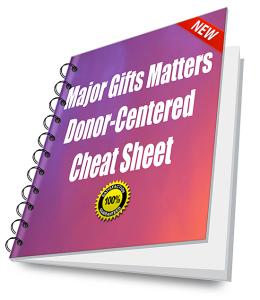Major Gifts Matters – A Donor-Centered Cheat Sheet
Why you should get this Cheat Sheet
Donors today want more hands-on involvement than last generation’s donors. They want choice. They won’t necessarily be content with earmarking their gift “for use where most needed.”
If you’re still insisting that your fundraiser ask primarily for unrestricted gifts, you’re likely leaving money on the table.
If you want your donors to make passionate major gifts, you need to think from their perspective. What’s in it for them? What really inspires them? What floats their boat?
At the same time, your organization has needs too. You want to cover overhead — salaries, finance, fundraising and administration. But no one wants to pay for these things!
In this Cheat Sheet I answer the most Frequently Asked Questions about offering donors choices.
- When does it make sense to ask for overall funding vs. designated program funding?
- When is it better to ask for a general gift vs. a specific amount?
- What are some of the advantages of asking for designated gifts?
- Are there some programs for which it’s better to ask for restricted funding than others?
- What if I raise too much money for one program?
- How do I get donors to fund overhead?
- How do I handle donors who refuse to pay for salaries?
- How do I structure a donor-friendly program narrative and budget?
- Do different generations require different kinds of options?
- Are Millenials different from Boomers?
- RESOURCE GUIDE
- Free gifts!!!
How much more money could you raise if leadership began to think from your donor’s perspective rather than their own?
A lot, is what I’m guessing.
Once I’ve raised my quota for restricted gifts I’m only allowed to ask for unrestricted gifts.
It’s best practice to ask for unrestricted gifts so there’s more flexibility in how we use the money. Donors understand this.
We’re allowed to ask for specific program funding only in foundation grant proposals. For individuals, we ask for gifts “where most needed.”
We need no-strings-attached cash gifts, so that’s what we tell donors.
If you’ve heard anything like this come out of your mouth (or that of your finance staff, executive management staff or board members), then this Cheat Sheet is important reading.
Do any of these statements sound familiar?
- Our Finance Department insists we raise only unrestricted gifts from individuals
- Our development staff have unrestricted giving quotas which must be met before we can ask for any type of restricted gift
- It’s impossible to get a clear description from program or finance staff as to how much money goes to program overhead
- Donors frequently tell us they don’t want to pay for salaries
- Donors think ‘overhead’ is a wasteful use of their philanthropy
If so, then you should get these FAQs about offering donors choices between restricted, unrestricted, program and overhead giving. Otherwise, you’re ignoring your organization’s future. You’re likely securing habitual gifts rather than passionate ones. And you’re raising a lot less money than you could were you to approach fundraising from a donor-centered perspective.
What’s inside?
- Undesignated vs. Designated Giving
- Overall Funding vs. Specific Programs
- Securing Funding for Overhead
- Talking to Donors about Overhead
- Presenting Clear Program Narratives and Budgets
- Approaches for Younger Donors
This is a simple.
Simple, yet powerful. If you follow this Cheat Sheet as a guideline for structuring your major gifts solicitation program, you’ll raise more money. This stuff works. Try it!

Clairification subscribers receive special discounts. To get yours, click here
All Clairification products are guaranteed. In fact, if you don’t make more money than you spend on this, I’ll make a donation to your nonprofit!


Clairification subscribers receive special discounts. To get yours, click here
All Clairification products are guaranteed. In fact, if you don’t make more money than you spend on this, I’ll make a donation to your nonprofit!